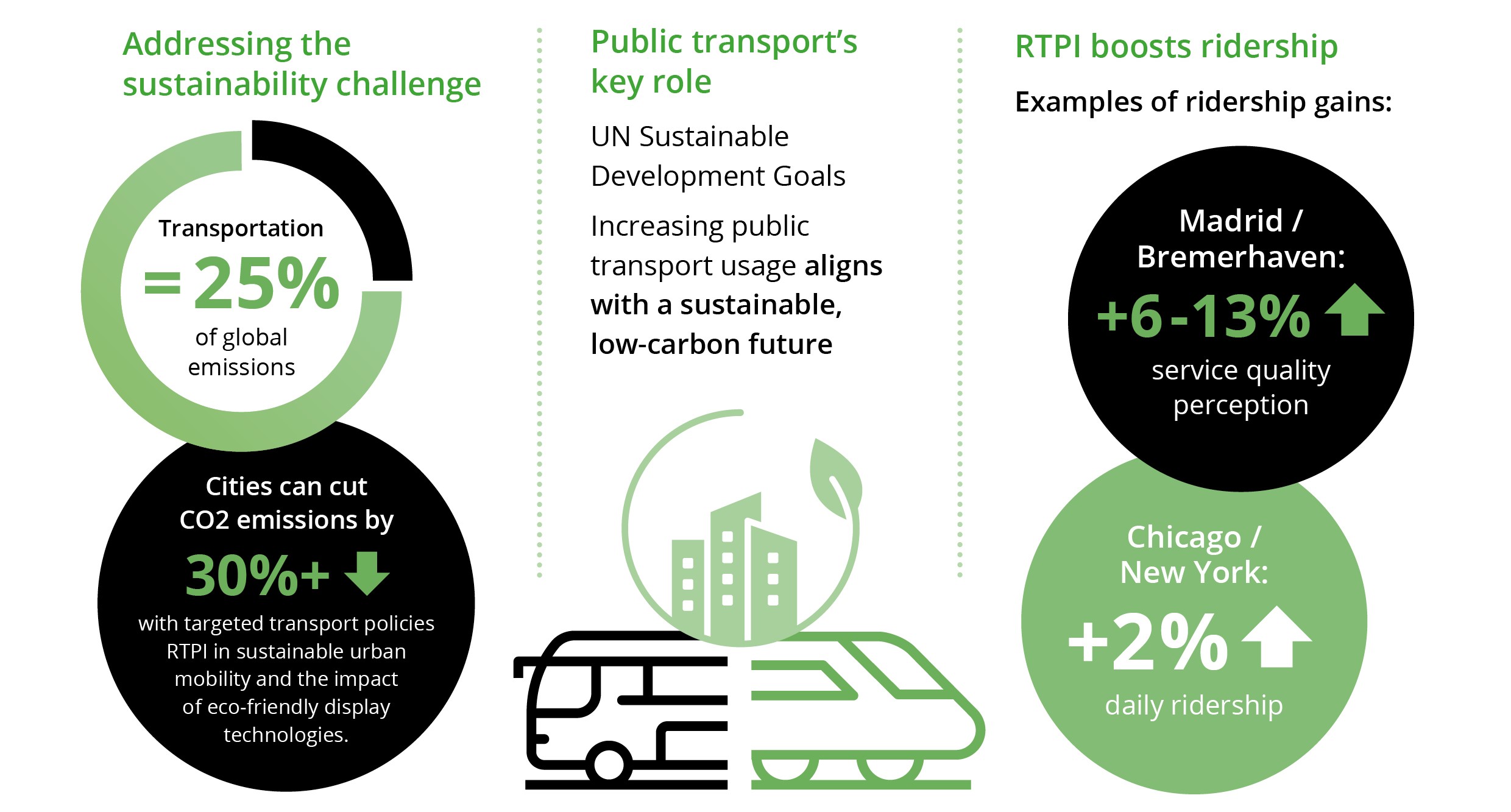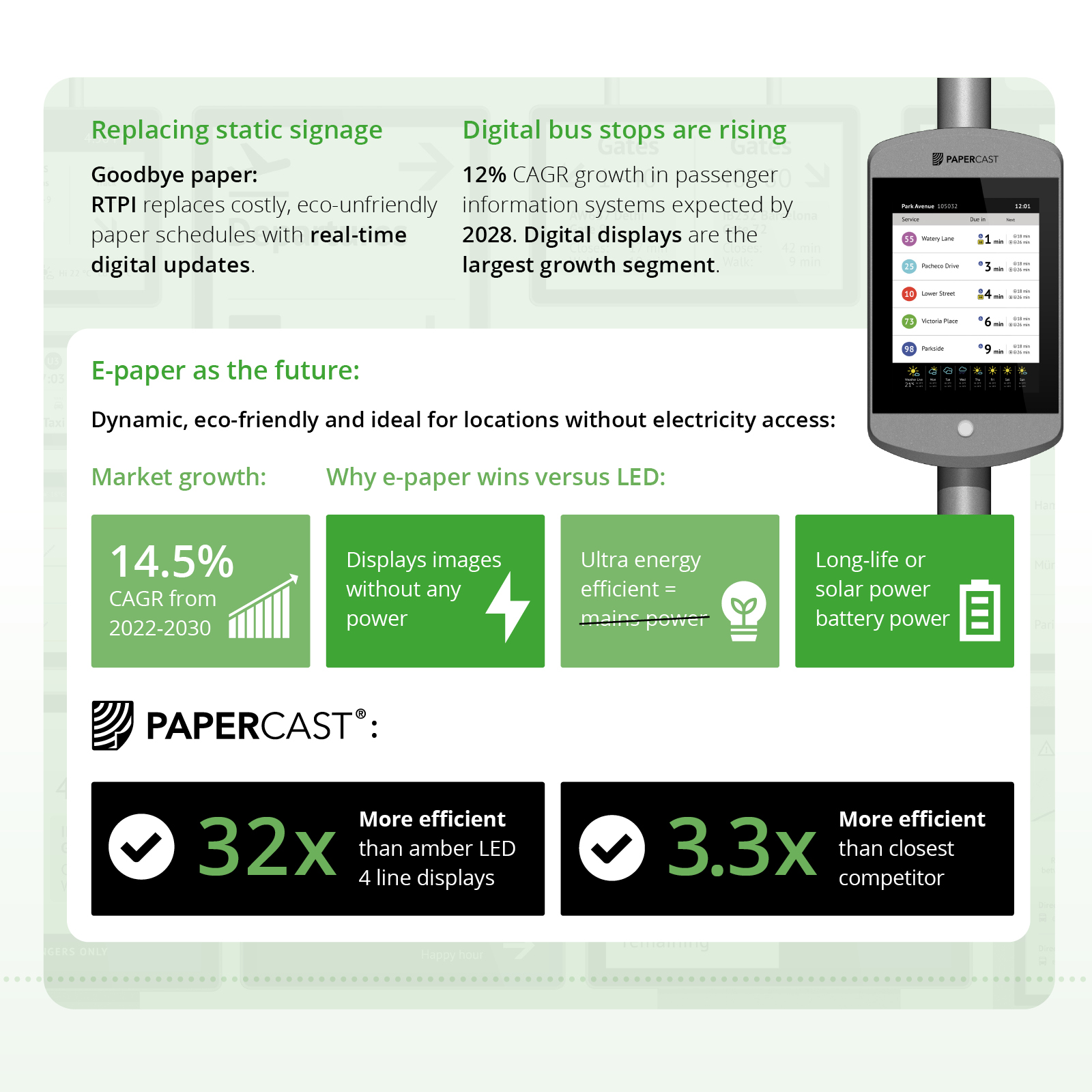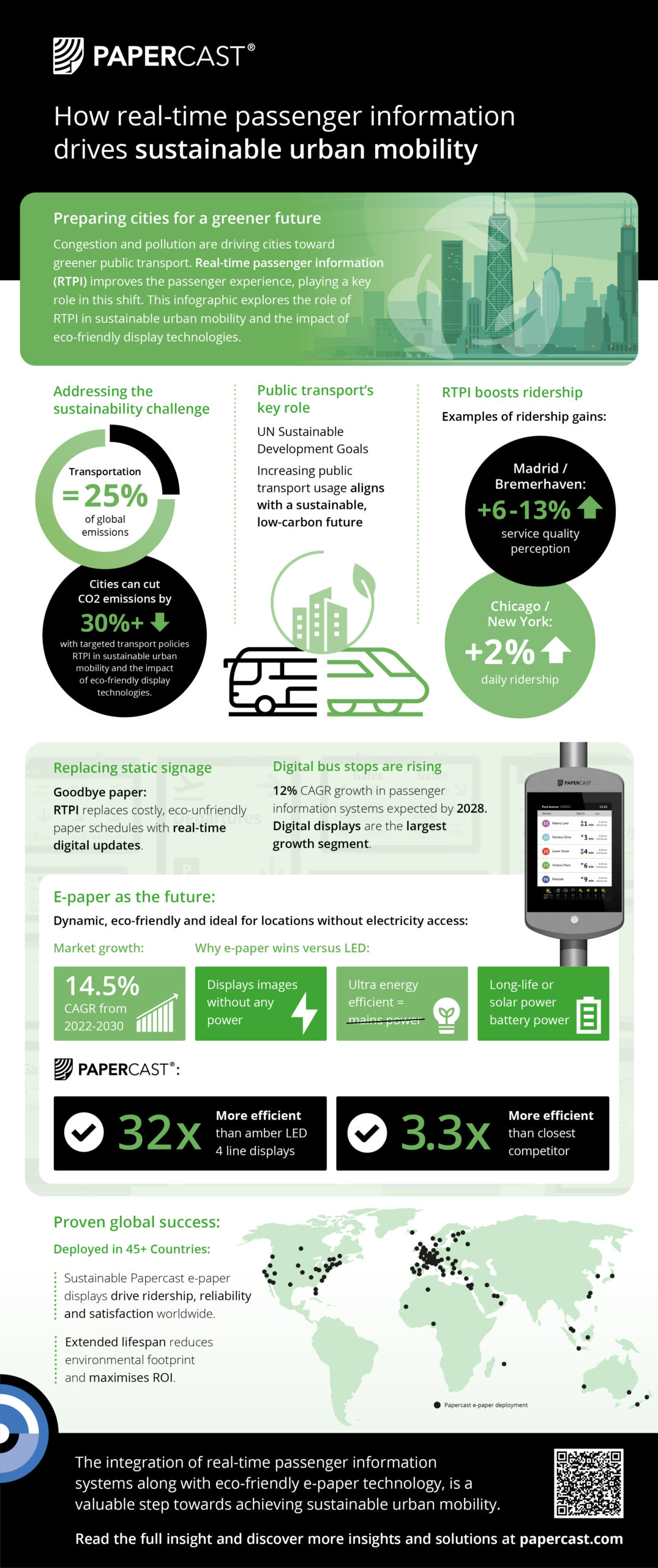
Meet the Papercast CMS Layout Catalogue: A must have resource for sharing visually impactful passenger information
We’re excited to tell you about the Papercast Content Management System (CMS) Layout Catalogue, an…

Our integrated 5 year battery sets a new standard in energy efficiency for e-paper bus stop displays. This article provides a backdrop and delves into the motivation behind our relentless commitment to innovation as we continue to redefine the boundaries of energy efficiency in our e-paper bus stop passenger information display solutions for modern transit systems.
In the pursuit for sustainable urban living, cities worldwide grapple with the twin challenges of congestion and pollution. A pivotal aspect of addressing these issues involves transitioning from private car use to more eco-friendly modes of transport, such as public transport.
At the heart of this movement is a multifaceted approach to improving the efficiency and attractiveness of public transit. Real-Time Passenger Information (RTPI) systems play a crucial role in this strategy. These systems aren’t just about bus schedules and arrival times; they empower commuters with greater certainty and allow them to make informed choices.
In this article, we’ll explore the vital role of passenger information in sustainable urban transportation and how companies like Papercast are enabling this change. Be sure to check out the supporting infographic at the end of the page.

1. The sustainability challenge: Urban areas face a pressing challenge with increasing car ownership and traffic levels. Transportation alone accounts for nearly a quarter of global greenhouse gas emissions. However, cities have the potential to enact significant change in this area, with studies indicating that targeted policies could slash transport CO2 by 30% or more.
2. The role of public transport: Cities worldwide are aligning with the UN Sustainable Development Goals, striving for a sustainable, low-carbon future. Increasing public transport usage stands as a cornerstone of this effort, aiming to combat urban congestion and pollution.
3. RTPI increases ridership: By reducing waiting times, boosting satisfaction and enhancing overall transportation efficiency, RTPI systems play a vital role in enhancing the quality of public transport services and encouraging ridership. Cities like Madrid and Bremerhaven reported 6-13% increase in perceived service quality, while Chicago and New York reported a 2% increase in daily ridership following RTPI implementation.
READ PAPERCAST INSIGHT: How real-time passenger information correlates with increased ridership and satisfaction

4. How RTPI is replacing paper-based static signage: Traditional paper-based schedules and maps at bus stops are gradually giving way to real-time digital displays. The costly and environmentally impactful process of printing and manually replacing paper timetables across a transit network can be significant.
5. The rise of real-time digital bus stops: Real-time bus stop displays offer dynamic updates on bus arrivals, departures and delays, as well as other important travel information. The global passenger information system market is expected to reach 12% CAGR by 2028, and display systems are expected to account for the largest share of grow.
6. Emerging digital bus stop technologies: Power-hungry LED 3 and 4 line signage was the default technology for many years, but it faces challenges related to the need for a mains power supply, high energy consumption and maintenance. Low-power alternatives like e-paper technology are now gaining traction.
READ PAPERCAST INSIGHT: Why e-paper is winning in the world of public transport signage
7. Innovation in display technology: Overcoming the hurdle of powering digital displays without mains electricity, e-paper emerges as a sustainable solution. E-paper is now becoming the de-facto technology for applications where transport providers need to get dynamic or real-time information to customers in a sustainable manner, and locations where mains power is not readily available. A recent report on the global e-paper display market predicts 14.5% CAGR between 2022-2030 and states “e-paper displays can complement smart city and green mobility concepts, which have enormous market growth potential”.
8. Energy efficiency number one priority: By harnessing the energy-efficient attributes of e-paper, Papercast has engineered its technology to deliver superior functionality and exceptionally low energy consumption. In fact, Papercast’s 13” e-paper displays have been tested to be 32x more power efficient than amber LED 4 line displays and 3.3x more efficient than its closest competitor. Excellent readability under direct sunlight, ruggedised enclosures and sustainable power solutions – 5 year long-life battery or solar power – make Papercast displays an environmentally friendly option for outdoor displays.
READ PAPERCAST INSIGHT: How energy efficient are Papercast® e-paper displays?
9. Proven success and global adoption: Papercast’s sustainable e-paper displays have been deployed in over 45 countries, earning praise from transit authorities and service providers worldwide. These displays have increased ridership, improved service reliability and enhanced passenger satisfaction.
10. Durability and sustainability through extended lifespan: Papercast e-paper displays are designed with durability and sustainability at their core, offering a significantly longer lifespan compared to traditional display technologies. This longevity not only maximises return on investment but also minimises the environmental footprint associated with frequent replacements.
By providing robust, weather resistant and low maintenance solutions, Papercast ensures that transit authorities can rely on their displays for years to come, fostering a more sustainable approach to real-time passenger information.
READ PAPERCAST INSIGHT: Maximise your investment: Extend the lifespan of Papercast e-paper signage
In conclusion, the integration of real-time passenger information systems along with eco-friendly e-paper technology, is a valuable step towards achieving sustainable urban mobility.
READ PAPERCAST NEWS: Papercast enhances entire e-paper signage portfolio with integrated long-life 5 year battery


We’re excited to tell you about the Papercast Content Management System (CMS) Layout Catalogue, an…

The REACT Trigger System is now available on Papercast displays We’re excited to share that…